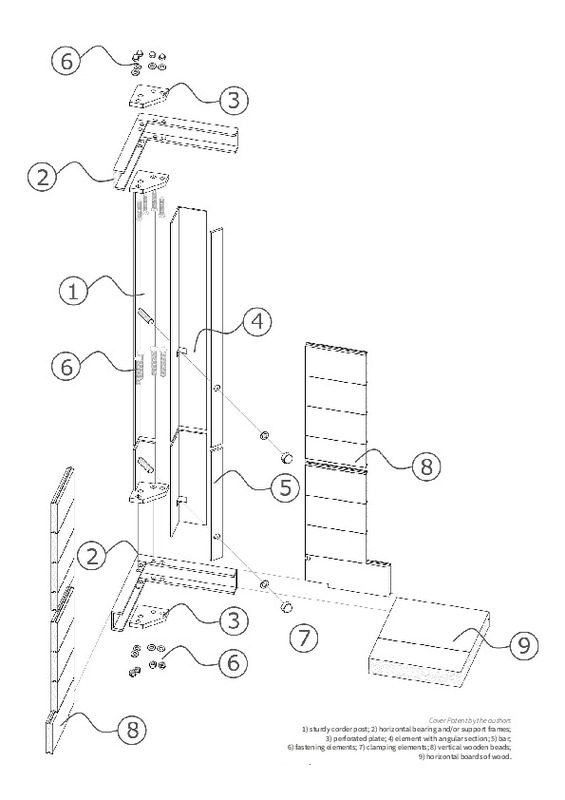JavaScript is disabled for your browser. Some features of this site may not work without it.
Buscar en RiuNet
Listar
Mi cuenta
Estadísticas
Ayuda RiuNet
Admin. UPV
Resilient connections
Mostrar el registro sencillo del ítem
Ficheros en el ítem
| dc.contributor.author | Rossi, Adriana
|
es_ES |
| dc.contributor.author | Gonizzi Barsanti, Sara
|
es_ES |
| dc.date.accessioned | 2021-07-06T09:25:40Z | |
| dc.date.available | 2021-07-06T09:25:40Z | |
| dc.date.issued | 2021-06-30 | |
| dc.identifier.uri | http://hdl.handle.net/10251/168824 | |
| dc.description.abstract | [EN] The paper presents Axis Strutture, patented by the authors, awarded with V:alere funds (VAnvitelli pER la ricErca 2020) for the establishment of an innovative start-up, now academic spin-off. It is based on the assemble of iron and wood with 'pins' (in Latin 'axis') threaded to ensure an economic profit in line with the Sustainable Development Goals, reviewing ancient technologies in the light of advanced research. The focus is on the structural connections of a construction system that clamps the steel frame elements with the wooden infill, allowing to assemble modular, prefabricated and flexible components customized on the design phase’s request. It provides effective emergency shelters assembled or dismantled as quickly as tents but more stable, healthier and comfortable. With a single star key, the steel uprights can be attested with wooden and similar tampons avoiding nails and screws which allows the total reuse of the components. The patented connections implement a new construction method promoting the self-construction of garden houses, leisure environments, bungalows, garages and quality housing modules, since they are resilient, resistant and with a controllable impact on the environment. The case study provides an opportunity to verify actions aimed at the implementation of Design for Adaptability strategies promoting virtuous life cycles that involves the entire community in sustainable models from an economic, environmental and social point of view. | es_ES |
| dc.description.sponsorship | The case study develops the application potential of an idea patented by the authors awarded with the V: alere funds (VAnvitelli pER la ricErca 2020) for the establishment of an innovative start-up, now an academic spin-of | es_ES |
| dc.language | Inglés | es_ES |
| dc.publisher | Universitat Politècnica de València | es_ES |
| dc.relation.ispartof | VITRUVIO - International Journal of Architectural Technology and Sustainability | es_ES |
| dc.rights | Reconocimiento - No comercial (by-nc) | es_ES |
| dc.subject | Construction system | es_ES |
| dc.subject | Intuitive | es_ES |
| dc.subject | Eco-sustainable | es_ES |
| dc.subject | Adaptive | es_ES |
| dc.subject | Anti-seismic | es_ES |
| dc.subject | Rebuilt | es_ES |
| dc.title | Resilient connections | es_ES |
| dc.type | Artículo | es_ES |
| dc.identifier.doi | 10.4995/vitruvio-ijats.2021.15375 | |
| dc.rights.accessRights | Abierto | es_ES |
| dc.description.bibliographicCitation | Rossi, A.; Gonizzi Barsanti, S. (2021). Resilient connections. VITRUVIO - International Journal of Architectural Technology and Sustainability. 6(1):24-37. https://doi.org/10.4995/vitruvio-ijats.2021.15375 | es_ES |
| dc.description.accrualMethod | OJS | es_ES |
| dc.relation.publisherversion | https://doi.org/10.4995/vitruvio-ijats.2021.15375 | es_ES |
| dc.description.upvformatpinicio | 24 | es_ES |
| dc.description.upvformatpfin | 37 | es_ES |
| dc.type.version | info:eu-repo/semantics/publishedVersion | es_ES |
| dc.description.volume | 6 | es_ES |
| dc.description.issue | 1 | es_ES |
| dc.identifier.eissn | 2444-9091 | |
| dc.relation.pasarela | OJS\15375 | es_ES |
| dc.description.references | Adjodha, Joshua. (2018). Structural Design for Adaptability and Growth. | es_ES |
| dc.description.references | Bullen, P. 2011. Factors influencing the adaptive re-use of buildings. Journal of Engineering, Design and Technology, 9, pp. 32-46. https://doi.org/10.1108/17260531111121459 | es_ES |
| dc.description.references | Israelsson, N. 2009. 'Factors influencing flexibility in buildings'. Structural Survey, 27, pp. 138-147. https://doi.org/10.1108/02630800910956461 | es_ES |
| dc.description.references | Lemer, A.C. 1996. 'Infrastructure Obsolescence and Design Service Life'. Journal of Infrastructure Systems, 2(4). https://doi.org/10.1061/(ASCE)1076-0342(1996)2:4(153) | es_ES |
| dc.description.references | Mallach, E. 2006. 'A Database Project in a Small Company (or How the Real World Doesn't Always Follow the Book)'. Journal of Cases on Information Technology (JCIT), 8(3), pp. 24-40. https://doi.org/10.4018/jcit.2006070103 | es_ES |
| dc.description.references | Manewa, A., Siriwardena, M., Ross, A., & Madanayake, U. 2016. 'Adaptable buildings for sustainable built environment'. Built Environment Project and Asset Management, 6(2). https://doi.org/10.1108/BEPAM-10-2014-0053 | es_ES |
| dc.description.references | Miller, Donald. 1996. City of the Century. New York: Paperbachs | es_ES |
| dc.description.references | Pinder, J.A., Schmidt, R., Austin, S.A., Gibb, A., & Saker, J. 2017. 'What is meant by adaptability in buildings?' Facilities, 35(1/2), pp. 2-20. https://doi.org/10.1108/F-07-2015-0053 | es_ES |
| dc.description.references | Remøy, H., de Jong, P., & Schenk, W. 2011. 'Adaptable office buildings'. Property Management, 29(5), pp. 443-453. https://doi.org/10.1108/02637471111178128 | es_ES |
| dc.description.references | Rockow, Zoraya Roldan, "Qualitative & Quantitative Analyses of Existing Buildings' Adaptability" (2020). All Dissertations. 2670. https://tigerprints.clemson.edu/all_dissertations/2670 | es_ES |
| dc.description.references | Turan, M. 2009. 'Reconstructing The Balloon Frame: A Study In The History Of Architectonics'. Metu Journal of The Faculty of Architecture, 26, pp. 175-209. https://doi.org/10.4305/METU.JFA.2009.2.10 | es_ES |








